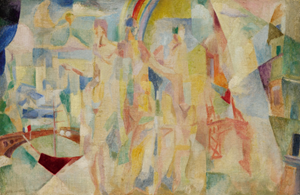
Painted in 1914, Le Ville de Paris, equisse presents one of the artist's most iconic subjects and indicates Delaunay's revolutionary transition from his earlier Cubist style toward his initiation of the Orphist movement.
Painted in 1914, Le Ville de Paris, equisse presents one of the artist's most iconic subjects and indicates Delaunay's revolutionary transition from his earlier Cubist style toward his initiation of the Orphist movement.
In a vibrant celebration of color and simplicity of form, Delaunay here depicts Paris, the city that figures most importantly in his oeuvre. He situates the Eiffel Tower, a symbol of his former Cubist deconstructions, in the distance and depicts the Three Graces in the foreground as an allegory for the grace and eloquence of his favorite city. Delaunay submitted an earlier iteration of this theme at the Salon des indépendants in 1912, a work now in the collection of the Centre Georges Pompidou in Paris. When he comes back to this subject in 1914, as in the current work, he relies upon the expressive potential of color and the dynamism of the Orphist style.
Delaunay's study of color theory was influenced by the painting of Georges Seurat, whose use of contrasting and complementary colors in his Pointillist compositions revolutionized painting at the end of the nineteenth century. Delaunay expanded upon the expressive potential of color in his painting, allowing an emphasis on color to dominate over the strictures of form. Max Imdahl wrote, "For Robert Delaunay, colors are the painter's actual language: 'Color is form and subject.' In addition, Delaunay considered the language of color the most human language imaginable in art. Every human being, he said, is capable of being affected by the universal language of colors, by their play, movement, chords, rhythms—in short, by those arrangements that are especially suited to man's natural inclinations" (Gustav Vriesen & Max Imdahl, Robert Delaunay: Light and Color, New York, 1967, p. 80).
Two years before he painted the present work, Delaunay wrote in a letter to Franz Marc on December 14, 1912: "I have an end, an artistic belief that is unique and that cannot be classified without risking becoming ponderous. I love poetry because it is higher than psychology. But I love painting more because I love light and clarity and it calms me. This is how I would have liked to be understood, but what does it matter after all? It is the image alone that is important..." (quoted in Visions of Paris: Robert Delaunay's Series (exhibition catalogue), Deutsche Guggenheim, Berlin, 1997, p. 129).

ArtDependence Magazine is an international magazine covering all spheres of contemporary art, as well as modern and classical art.
ArtDependence features the latest art news, highlighting interviews with today’s most influential artists, galleries, curators, collectors, fair directors and individuals at the axis of the arts.
The magazine also covers series of articles and reviews on critical art events, new publications and other foremost happenings in the art world.
If you would like to submit events or editorial content to ArtDependence Magazine, please feel free to reach the magazine via the contact page.